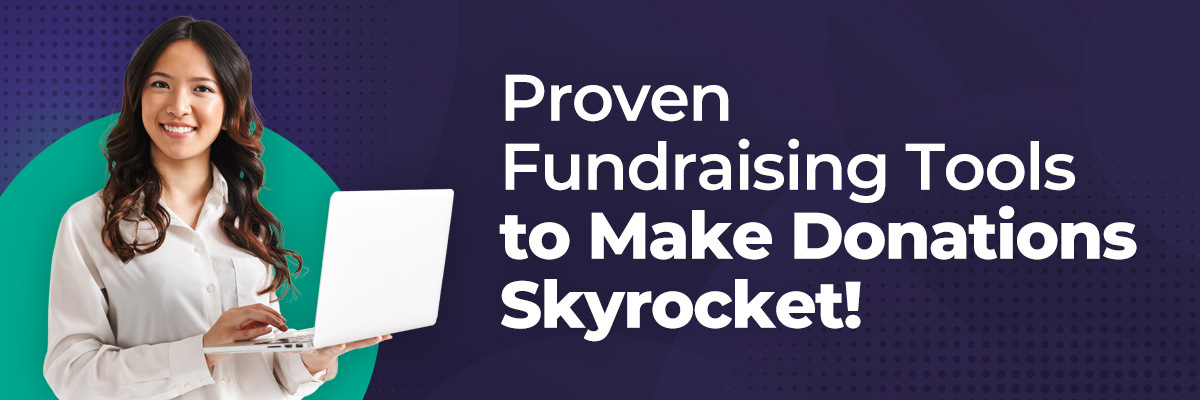
The stress and workload associated with running a nonprofit organization can sometimes tire donors and organizations alike. "Donor fatigue" refers to the feeling experienced by many when overwhelmed by incessant requests for donations. On the other side is "fundraising fatigue," which happens when the organizations fail to excite their donors or have failed to run effective fundraising programs.
Staying in touch is critically important! Meaningful conversations and touch points with your supporters can help stop this fatigue from setting in. In this post, we will cover how to recognize donor and fundraising fatigue while sharing some effective ways to engage your supporters in a resounding and high-impact manner about your mission.
Table of Contents
- What is Donor Fatigue?
- What is Fundraising Fatigue?
- Why It’s Important to Distinguish Between the Two
- Best Practices for Preventing Donor Fatigue
- Strategies to Combat Fundraising Fatigue
- How Vanco Can Help Your Non-Profit
- 100+ Free Fundraising Tools for Nonprofits to Inspire Unprecedented Generosity!
What is Donor Fatigue?
Donor Fatigue Definition:
Donor fatigue is when supporters are tired of persistent donation requests, thus leading to a nosedive in income. According to the Fundraising Effectiveness Project, the average donor retention rate is a mere 45%.
Causes
- Overexposure to donation appeals.
- Lack of transparency about fund usage.
- Insufficient communication of impact.
Signs
- Declining donation amounts.
- Reduced donor engagement.
- Increased donor attrition rates.
What is Fundraising Fatigue?

Definition
Fundraising fatigue happens when those responsible for raising funds for a nonprofit organization feel worn out and lose motivation. This often happens when there’s constant pressure to meet ambitious fundraising targets or come up with fresh ideas. As the demands on nonprofits increase, the financial returns often don’t keep pace, leading to burnout. The Council of Non-Profits reports that over 50% of nonprofits noted stress and burnout as a core cause of difficulties in retaining staff.
Causes
There are a few reasons why fundraising fatigue can happen:
- Unrealistic Fundraising Goals: When nonprofits set very high targets, the pressure can overwhelm fundraising teams and lead to stress and fatigue.
- Repetitive Fundraising Efforts: Using the same approaches or campaigns over and over can become monotonous. When campaigns start to feel uninspired, the team may struggle to stay motivated.
- Limited Resources and Support: A lack of personnel, time, or tools can make fundraising more challenging, leading to feelings of frustration and burnout.
Signs
It’s important to recognize the signs of fundraising fatigue so you can address it. Here are some clues that it might be happening:
- Exhaustion Among Staff: If the team in charge of fundraising seems overwhelmed or burned out, it’s likely a sign of fatigue.
- Declining Fundraising Results: If campaigns and activities are not bringing in as much revenue as before, it could be a result of a fatigued team.
- Drop in Enthusiasm: When the fundraising team seems less passionate or motivated to engage with donors, this lack of enthusiasm can be a clear signal that burnout is setting in.
Understanding and addressing fundraising fatigue is essential to maintaining a healthy, motivated team. By identifying its causes and signs, nonprofits can take steps to prevent burnout and keep their fundraising efforts on track.
Strategies to Prevent Donor Fatigue
To keep donor fatigue from happening, it’s important for non-profits to use some smart strategies. By staying connected and engaged with supporters, organizations can make sure donors feel valued and excited to help out. Below are some effective ways to prevent donor fatigue.
Use Different Ways to Communicate
It’s important to keep your outreach fresh and engaging by mixing up the ways you connect with donors. While email is useful, don’t rely on it alone—consider using social media, hosting events or creating videos to tell your story. Mixing up how you communicate helps keep donors engaged and strengthens their connection to your cause.
Be Transparent with Your Donors
Donors want assurance that their contributions are being used wisely. In fact, Donor Direct says 75% of donors are more likely to give again when they can see the tangible impact of their donation. Providing regular updates and clear insights into how funds are spent not only builds trust but also reassures donors that their support is making a real difference.
Personalize Your Donor Relationships
Personal recognition goes a long way in donor retention. Research shows that 65% of donors would give more if they understood how their contributions were being used. Small, personal touches—like sending handwritten thank-you notes or mentioning donors in your updates—can help them feel appreciated and more invested in your mission.
Offer Flexible Giving Options
Donors have different financial capacities and preferences, so offering flexible donation options allows them to give in a way that works for them. While only 20% of first-time donors give again, Double the Donation reports they’re 60% more likely to make a second donation if they’ve had a positive experience. Offering recurring donation options can give supporters the flexibility they need and encourage long-term support without overwhelming them.
By incorporating these strategies, nonprofits can build stronger, more sustainable relationships with their donors and reduce the risk of burnout. Keeping supporters engaged and valued ensures they’ll continue to invest in your mission.
Strategies to Avoid Fundraising Fatigue
Preventing fundraising fatigue is as important as keeping donors happy!
When people in charge of raising money get tired or stressed out, this could reverberate to the whole organization. So here are effective strategies that can help fundraising teams keep their forces motivated and energized:
Setting Realistic Goals
Setting achievable fundraising targets is one of the surest ways to avoid burnout. When goals are unrealistically high, there will be lots of stress involved with the feeling that they are impossible to meet. When realistic goals are set up, then it's easy for the fundraising teams to stay motivated and feel accomplished once they can meet those goals.
Encourage Professional Development
Investing in training programs can really help fundraising staff grow their skills and knowledge. Clear Company reports that 80% of nonprofit employees say learning and development opportunities would help them feel more engaged in the job.
The excitement of fresh techniques and perspectives keeps their work fresh and exciting when they learn new things. And oh, that begets motivation!
Work-Life Balance
Your fundraising staff needs adequate time to rest and enjoy their private lives. A good work-life balance keeps your staff from burning out. When team members feel refreshed, they are able to bring more energy and enthusiasm into work.
Teamwork Makes the Dream Work!
What makes quite a big difference is the creation of a teamwork culture in which the fundraising team either collaborates or supports each other in their activities and celebrates successes together. This keeps everyone motivated and ready to accept any challenge.
These methodologies will help non-profits avoid fundraising fatigue and keep their teams energized. If supported and motivated, the fundraisers can work toward their goals effectively!
Key Differences Between Donor Fatigue and Fundraising Fatigue
Understanding the difference between donor fatigue and fundraising fatigue is important for non-profits. While they both deal with a sense of tiredness or being overwhelmed, they occur in different groups and may have very different impacts. We will discuss a series of significant discrepancies between the two types of fatigue, including symptoms and causes and how to prevent them. Also, we can describe how they both can harm the sustainability of a nonprofit organization in this section. Let's take a look!
Comparison Table
|
Aspect |
Donor Fatigue |
Fundraising Fatigue |
|
Symptoms |
- Declining donation amounts |
- Burnout among fundraising staff |
|
|
- Reduced engagement in your donor base |
- Reduced effectiveness in fundraising efforts |
|
|
- Increased donor attrition rates |
- Lowered morale and enthusiasm |
|
Causes |
- Overexposure to donation requests |
- High-pressure fundraising goals |
|
|
- Lack of transparency about fund usage |
- Repetitive fundraising campaigns |
|
|
- Insufficient communication of impact |
-Limited resources and support |
|
Prevention Methods |
- Diversify communication channels |
- Set realistic goals |
|
|
- Enhance transparency |
- Encourage professional development |
|
- Personalize engagement |
- Promote work-life balance |
|
|
|
- Offer flexible giving options |
- Offer flexible giving options |
Impact on Non-profit Sustainability
Both donor fatigue and fundraising fatigue will mean problems for the sustainability of a non-profit. The donors will get tired of giving-in, hence less will be coming in. On the other hand, if the staff that conducts fundraising get overwhelmed and burnt out, they may not be able to raise funds required for certain projects. This creates a vicious circle that in turn makes it even more difficult for the non-profit organization to succeed.
By better understanding some of these key differences, nonprofits can take action in support of both their donors and fundraising teams so that they remain strong and effective in accomplishing their mission.
How Vanco’s Nonprofit Services Can Help Prevent Donor and Fundraising Fatigue
Keeping major donors, donors in general and your fundraising teams happy is key to non-profits, and Vanco offers some great services to that end! With tools designed to make it easier to manage donations and fundraising, Vanco can help organizations avoid donor and fundraising fatigue. Here's how Vanco's services can make all the difference:
Online Donations
With Vanco's donation tools, managing campaigns is relatively easy. It simplifies donation and, as such, helps organizations execute efficient, high-reaching fundraising campaigns. This also serves to avoid donor fatigue since one can diversify donation channels in the process of making it rather simpler for supporters to give through a way that best works for them.
Recurring Donations
One of the prime features that Vanco offers is the ability to do recurring donations. This enables your donors and prospective donors to create automatic contributions whereby nonprofits get consistent support without needing them to start new campaigns every other day. It, therefore, reduces pressure upon fundraising teams by enabling them to pay more attention to other important tasks without feeling overwhelmed.
Text Giving
Another wonderful way to make donations easy and not overwhelming is Vanco's text giving feature. What someone needs to do to give is simply to send a text, which is really very convenient. This helps one avoid overwhelming them by requests yet still supporting their favorite causes in an easy manner that is quick.
Engagement Analytics
Vanco also features engagement analytics, where nonprofits are given insight into the ways their donors are engaging with campaigns. It helps organizations understand what works and what does not work to institute changes that will influence donors to continuously engage further with them in giving.
With these valuable tools, Vanco is able to help nonprofits avoid donor and fundraising fatigue so organizations can keep doing their great work-while continuing to energize donors and teams alike!
FAQs
How can nonprofits prevent donor fatigue?
Nonprofits are able to help donors stay excited about giving by paying attention to when donors start to feel burnt out. They have to find other means of asking for help and should communicate the way donations are utilized. They develop a sense of appreciation for donations by making public the excellent things achieved through donations, which keeps donors interested. Instead of messaging that begs for money over and over, charities can sometimes send messages their way for each individual donor. They can be held pleased and active by telling stories, sending updates, and with the use of emails, social media, events.
How does Vanco’s recurring donation feature help prevent donor fatigue?
Vanco's recurring donation feature simplifies the giving process by allowing donors to set up automatic regular contributions. This lessens the need for frequent donation requests and reduces the risk of donor fatigue. Since donors have a choice of the amount and frequency, it puts them in control; hence, they may not easily feel compelled or overwhelmed. Consistent giving options build a sense of partnership with the cause that encourages ongoing further engagement without repetitive appeals.
How can Vanco’s analytics tools help manage donor relationships?
Vanco's analytics tools show nonprofits when and how people like to give, enabling nonprofits to send the right message to the right person at the right time. They will know which donors may need special attention or a personal note. By observing the frequency and size of gifts, they will know how often not to ask so they know when the best times are to reach out.
How does work-life balance contribute to reducing donor fatigue?
When the staff isn't overwhelmed, they can create much more engaging campaigns with donors. When the team is stressed and constantly asking for money, donors may feel bombarded and tired. On the other hand, when the staff have time to get reenergized, they connect much better with donors, and that keeps donors excited and engaged. It simply means happy staff equals happy donors!
How can Vanco support long-term fundraising success?
Vanco software supports long-term fundraising success through the various tools that will be described below: recurring giving, donor communication, and analytics. Recurring donations create predictability in a financial base. Moreover, the analytics that Vanco offers enable strategic decision-making as nonprofits adapt over time. Since donors go through an easy and seamless process for online and mobile donations, Vanco raises the chances for continued retention of donors, which is key to sustaining fundraising.
100+ Free Tools for Nonprofits to Inspire Unprecedented Generosity!
We’ve put together 100+ pro tools and templates that are guaranteed to boost your nonprofit’s fundraising—no guesswork, no fluff. Here’s what’s inside:
- Word-for-word fundraising scripts that turn "no" into "yes"
- Fundraising letter, email and thank you templates for every situation.
- Event planning and evaluation tools including checklists, reports, evaluations, surveys and more
- Plug-and-play sponsorship proposals and templates sponsors can't resist
- Free design materials that make your events look professional
- Donation Receipt Templates for every type of contribution
- 7 AI bots to handle repetitive tasks and save you hours
The only question left: Are you ready to turn the chaos into success?
Act now!
5 Minutes to Fundraiser Success: The No-Hassle, Risk-Free Event Management Option for Nonprofits

Imagine setting up your next fundraising event in just five minutes. That’s what Vanco does for you—no learning curve, just a quick setup and an easy, intuitive system. You can try it risk-free and discover what thousands of nonprofits already know: event management doesn’t have to be a chore.










